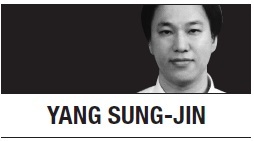[Yang Sung-jin] Never underestimate Naver dominance
By Yang Sung-jinPublished : July 19, 2017 - 17:49
 South Korean media are pinning their survival hopes on transforming their print-oriented business models into digital-centered alternatives in the coming years. The monopoly of Naver in the news media sector, however, threatens to derail the plan.
South Korean media are pinning their survival hopes on transforming their print-oriented business models into digital-centered alternatives in the coming years. The monopoly of Naver in the news media sector, however, threatens to derail the plan.
In fact, Naver dominates not only South Korea’s news media market but also virtually all major digital business sectors, ranging from keyword search ads to webtoons to blogging to online communities to video to entertainment.
While Samsung Group, the country’s biggest conglomerate, controls a wide range of offline businesses, Naver is seen as the online equivalent of Samsung with its grip on lucrative digital platforms becoming more overwhelming than ever.
The origin of Naver’s corporate history traces back to Samsung. In 1997, Naver was created as an in-house startup of Samsung SDS, the IT service arm of Samsung Group. It was just a small startup; now it’s a behemoth in Korea with an annual ad revenue of nearly 3 trillion won ($2.53 billion) -- twice the combined revenue of the 3,700 newspapers in South Korea.
Naver’s reach is not limited to Korea. It is the parent company of Line, known for the Line messaging app in Japan. And guess which company developed Snapchat clone Snow? Hint: it starts with “N” and ends with “r.”
Back to Korean media companies. Years ago, Korean newspapers held the terribly misguided belief that providing news to Naver and other portals would lead to greater influence and profits. Naver skillfully promoted its own portal services by incorporating all the news content from major media outlets. Naver users were happy because they could read news on Naver for free and without bothering to visit individual media sites.
As the trend in favor of Naver’s all-in-one news service continued, Korean online users no longer pay attention to individual media companies or their brands. They remember reading news items on Naver, but could not tell you where they came from.
Naturally, local newspapers, already beset by the declining print ad revenue, attempted to pull out of the shackles of Naver by introducing premium news services and overhauling their cluttered websites. The result was complete failure. No Korean newspaper has successfully launched a paid news service yet. News is largely consumed free of charge on Naver and second-ranked Daum. Newspapers, broadcasters and magazines willy-nilly continue to provide their content to Naver for a meager monthly fee.
A couple of changes, meanwhile, are afoot in and outside of Korea, signaling that Naver’s monopoly has gone too far and a set of measures must be taken. First, Google is trying to handle a platform neutrality issue in Europe, as it was slapped with a huge fine by the European Commission.
Second, the Korean government, now led by President Moon Jae-in, has started exploring platform neutrality. If the local regulators begin to review how search results, news and shopping information are exposed on Naver, the impact could be significant.
Perhaps sensing the forthcoming challenges, Naver has lost no time in preparing safety measures. Earlier this month, the country’s largest internet portal unveiled a plan to build a 10 billion won fund aimed at bolstering the paid subscription of individual newspapers on its news platform. Naver also pledged to share 70 percent of its ad revenue coming from the news section with member news outlets.
The new fund and revenue-sharing scheme, if combined, would translate into a total of 20 billion won in additional revenue for local media firms on a yearly basis.
Naver also plans to offer more detailed user data while expanding reporters’ profile pages on Naver’s news section in the name of strengthening the brand power of individual journalists.
The initial reaction from local newspapers appears to be mixed, at best. Naver’s pledge of additional revenue stops far short of fully compensating for the cost of generating news, and its upgraded reporter’s profile system is likely to steer more readers to Naver’s news page, not the websites of individual newspapers.
Personally, I envy Japanese news outlets, which did not cave in to the free online news boom. You have to pay to read news from Japanese newspapers and magazines. In Korea, you can read news without paying a dime, but the majority of readers prefer staying in Naver’s cozy digital ecosystem, and do not like to visit individual media sites. Worse, there’s no breakthrough in sight that would enable local media to stay financially independent and at the same time retain their online influence without relying on Naver’s news platform.
It remains to be seen how Naver’s fresh proposals will change the local media landscape, which is fraught with problems. One small consolation, though, is that Naver is not perfect. Naver dominates nearly all the major digital platforms here, but its music streaming service lags behind the country’s top-ranked Melon. At least for now.
By Yang Sung-jin
The writer is multimedia editor of The Korea Herald. He can be reached at insight@heraldcorp.com — Ed.








![[Graphic News] More Koreans say they plan long-distance trips this year](http://res.heraldm.com/phpwas/restmb_idxmake.php?idx=644&simg=/content/image/2024/04/17/20240417050828_0.gif&u=)
![[KH Explains] Hyundai's full hybrid edge to pay off amid slow transition to pure EVs](http://res.heraldm.com/phpwas/restmb_idxmake.php?idx=644&simg=/content/image/2024/04/18/20240418050645_0.jpg&u=20240419100350)






![[From the Scene] Monks, Buddhists hail return of remains of Buddhas](http://res.heraldm.com/phpwas/restmb_idxmake.php?idx=652&simg=/content/image/2024/04/19/20240419050617_0.jpg&u=20240419175937)

![[KH Explains] Hyundai's full hybrid edge to pay off amid slow transition to pure EVs](http://res.heraldm.com/phpwas/restmb_idxmake.php?idx=652&simg=/content/image/2024/04/18/20240418050645_0.jpg&u=20240419100350)

![[Today’s K-pop] Illit drops debut single remix](http://res.heraldm.com/phpwas/restmb_idxmake.php?idx=642&simg=/content/image/2024/04/19/20240419050612_0.jpg&u=)